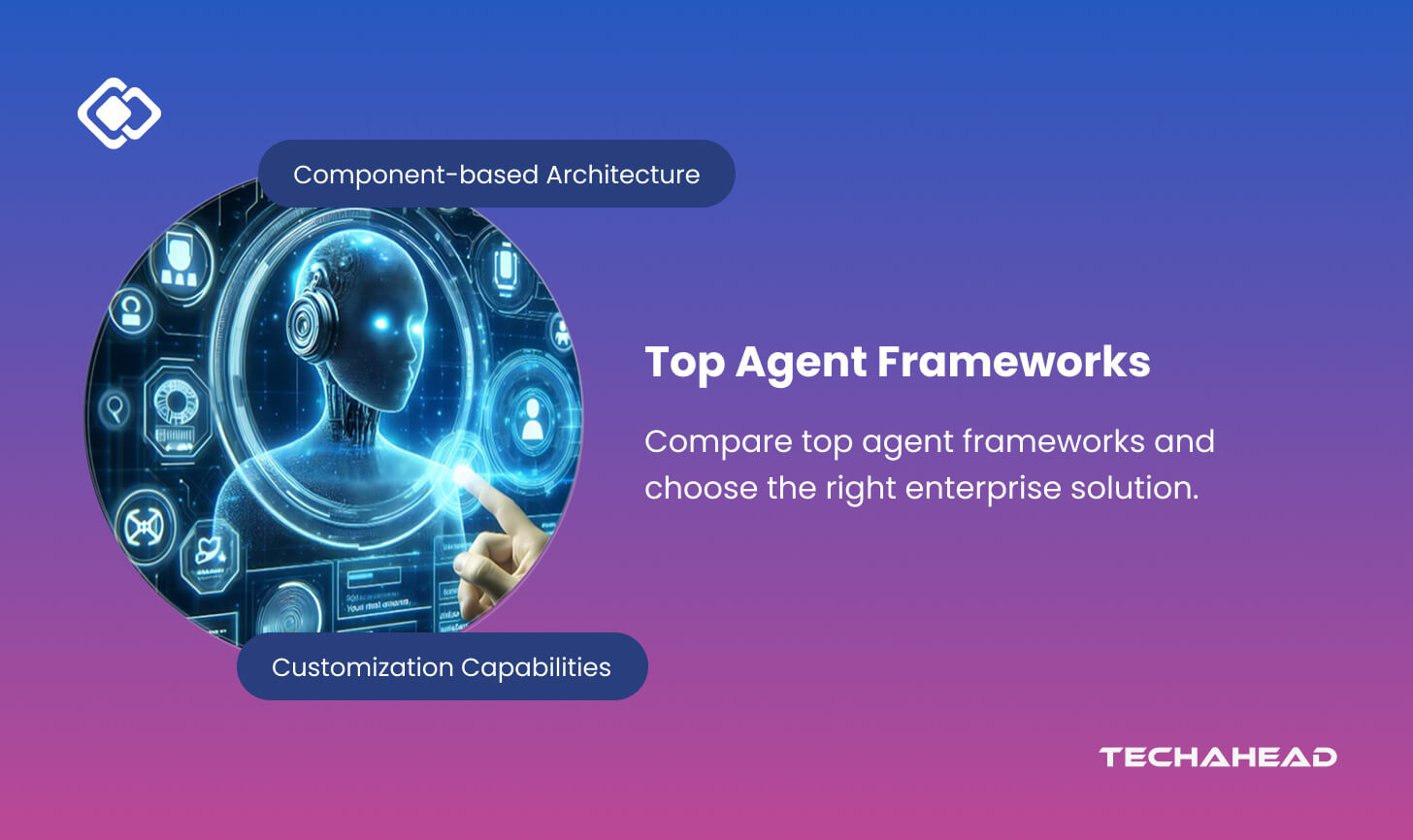“Agentic AI represents a fundamental leap toward autonomous systems that can reason, plan, and execute complex tasks with limited human input.” – Sam Altman, CEO OpenAI
If Artificial Intelligence is the engine that surprised the world, then Agentic AI is the fully autonomous, self-driven car that is forcing the world to evolve.
AI agents have literally transformed the tech ecosystem by shifting the landscape from being just a rule-based automation to autonomous, goal-driven decision systems.
And we have actual data to prove it.
When AI developers working on customer support workflows via Langchain ecosystem deployed a multi-agent framework over single-agent bots, they suddenly experienced a 45% boost in resolution rates.
This directly impacted their bottom line and revenues.
Another example.. As per McKinsey, when a retail bank deployed agentic AI platform to support relationship managers in creating credit-risk memos faster, they experienced upto 60% boost in productivity, and 30% faster credit turnaround time.
Again, directly impacting their bottom line. And profits.
Now, the challenge lies here: Choosing the right agentic AI framework for deploying an army of AI agents.
Depending on the specific needs and expectations of different business processes and systems, we need to select the most appropriate tool.
In this blog, we explore the three most popular and widely used agentic AI builders: OpenAI Agent Builder, LangGraph, and AutoGen Studio, and help you make an informed decision that is aligned with your business goals.
Whether you are a CTO of a company, searching for scalable enterprise-grade agentic AI solutions, or a research scientist seeking automation for complex workflows, or a solo, passionate developer who is prototyping ideas.. This in-depth comparison, with a highly sophisticated decision matrix will empower you to select the best Agentic AI builder suited for your needs.
Key Takeaways
- Agentic AI shifts automation from reactive task-execution to autonomous goal-achievement.
- OpenAI for speed. LangGraph for flexibility. AutoGen for rapid prototyping.
- Proven enterprise adoption: Klarna, AppFolio, Elastic, Qualtrics delivering measurable results.
- Production readiness, customization depth, cost structures, human-in-loop capabilities differ fundamentally.
- Deployment ranges from hours to quarters depending on complexity and scale.
- Use detailed decision matrix: evaluate team expertise, project scope, budget constraints.
What is an Agentic AI Builder?
Let’s understand the concept of Agentic AI Builder with a real-life example.
Agentic AI platforms, such as OpenAI Agent Builder or LangGraph or AutoGen Studio, among others, are like a toy factory, creating different toys.
Now, instead of programming every step and movement of the toys, these AI builders create smart toys that just need a prompt to act. For example, we can just tell the toy: “go make me a sandwich”, and it will figure it out autonomously, how to create the sandwich, and deliver it to you.
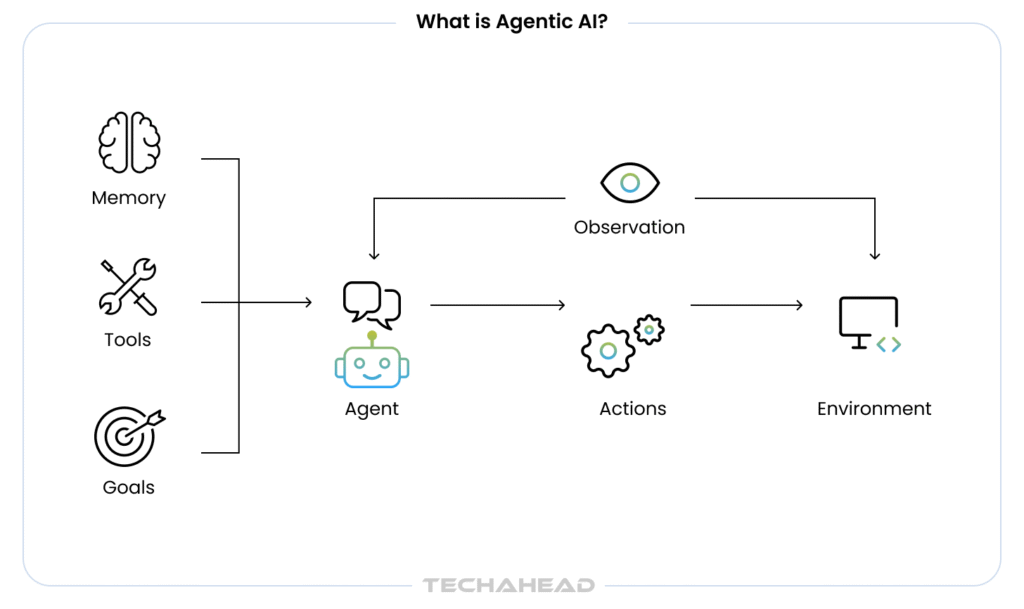
These smart toys are the AI Agents that are changing everything about how businesses operate and function.
In technical terms, an agentic AI platform is a framework that simplifies the process of creation, orchestration, and deployment of autonomous AI agents for specific processes and operations.
Such frameworks remove the complexities associated with agent development, empowering the developers and analysts to focus on solving the business problems and developing business logic, rather than spending hours of programming and creating the architecture of the AI agents.

Key Capabilities of Modern Agentic AI Builders
Autonomy & Reasoning: Agents make decisions independently within defined parameters, reducing the need for constant human intervention.
Multi-Step Workflows: Support for sequential, parallel, and conditional task execution across multiple agents.
Tool Integration: Seamless connection to APIs, databases, web services, and custom functions.

Human-in-the-Loop: Built-in mechanisms for human review, approval, and intervention at critical decision points.
Observability & Debugging: Real-time visibility into agent reasoning, state management, and performance metrics.
Scalability & Reliability: Infrastructure designed to handle long-running agents, state persistence, and fault tolerance.
These capabilities enable organizations to automate complex business processes that would otherwise require significant manual effort or complex custom development.
Overview of the Three Agentic AI Builders
As shared earlier, we will share an in-depth analysis and comparison of the top three industry leaders in the ecosystem of agentic AI.
Let’s start with OpenAI Agent Builder, the house where ChatGPT is born.
OpenAI Agent Builder
OpenAI’s Agent Builder provides a visual canvas for composing logic with drag-and-drop nodes, connecting tools, and configuring custom guardrails. It supports preview runs, inline eval configuration, and full versioning: Ideal for fast iteration.
Core Features
- Visual workflow canvas with drag-and-drop interface
- Custom tool calls that train models to call the right tools at the right time for better reasoning and custom graders that set custom evaluation criteria for what matters most in your use case
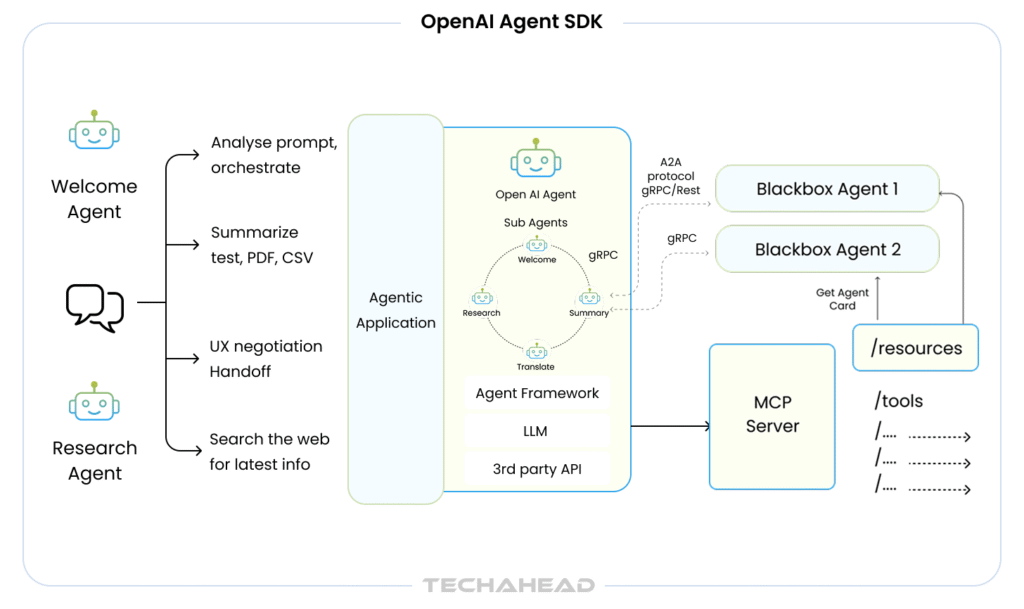
- Integration with OpenAI’s latest models including GPT-5
- Connector Registry for centralized management of APIs and tools across OpenAI products
- Version control and release management
- ChatKit for embedding chat interfaces in applications
Pricing Model
Agent Builder itself isn’t a separate paid product. You can design and iterate on the visual canvas at zero cost until you hit Run. Charges kick in when your workflow actually calls models or tools; OpenAI also notes that general billing for the new agent stack begins November 1, 2025.
Real-World Impact
At Ramp, the team went from a blank canvas to a buyer agent in just a few hours. Agent Builder transformed what once took months of complex orchestration, custom code, and manual optimizations into just a couple of hours.
The visual canvas keeps product, legal, and engineering on the same page, slashing iteration cycles by 70% and getting an agent live in two sprints rather than two quarters.
LangGraph
LangGraph’s flexible framework supports diverse control flows, single agent, multi-agent, hierarchical, and sequential, and robustly handles realistic, complex scenarios. With built-in statefulness, LangGraph agents seamlessly collaborate with humans by writing drafts for review and awaiting approval before acting.
Core Features
- Graph-based architecture for expressive, customizable workflows
- Directed graph structure enabling tasks like conditional decision-making, parallel execution, and persistent state management
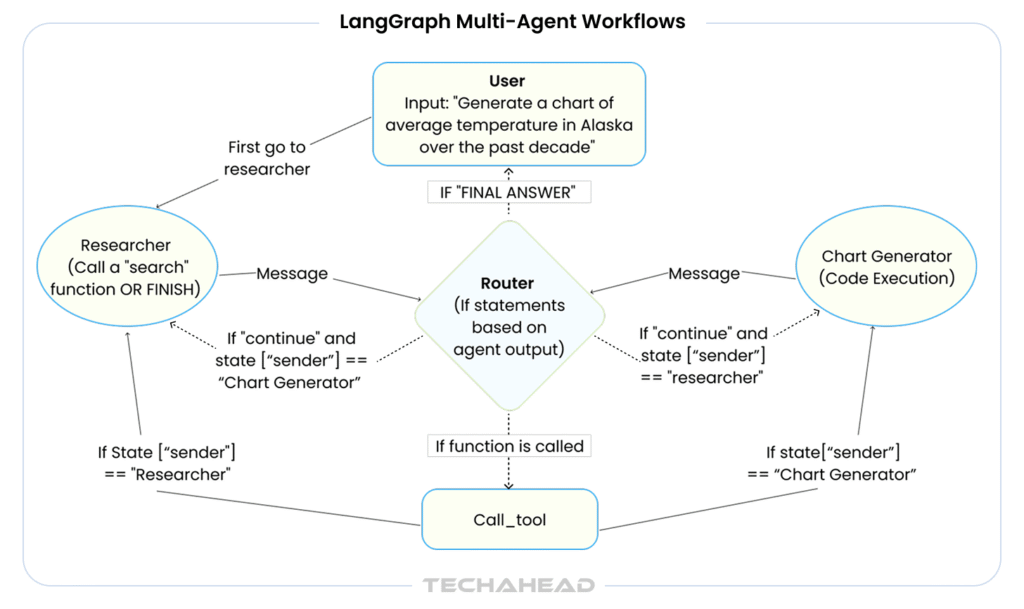
- Human-in-the-loop with checkpointing and interruption capabilities
- LangGraph Studio for easy debugging, visibility, and iteration, plus native integration with LangSmith for observability
- Support for single to hierarchical multi-agent orchestrations
- Time-travel debugging for troubleshooting complex workflows
Pricing Model
LangGraph is an MIT-licensed open-source library and is free to use. You can deploy your LangGraph application using LangSmith Deployment, available in the LangSmith Plus and Enterprise plans. Pricing for LangGraph costs an additional $0.001 per node.
Enterprise Adoption
LangGraph has demonstrated strong enterprise adoption with documented success stories. Klarna’s customer support bot serves 85 million active users and, has reduced resolution time by 80%. AppFolio’s Copilot Realm-X improved response accuracy by 2x, while Elastic uses it for AI-powered threat detection in SecOps tasks.
AutoGen Studio
AutoGen Studio (version 0.1.0) is a low-code interface for rapidly building, testing, and sharing multi-agent solutions. AutoGen Studio is built on AutoGen and inherits its features and functionalities, while providing a user-friendly and intuitive interface to create and customize agents, with little to no coding required.
Core Features
- Low-code GUI for building multi-agent applications
- Drag-and-drop composition of agent teams and workflows
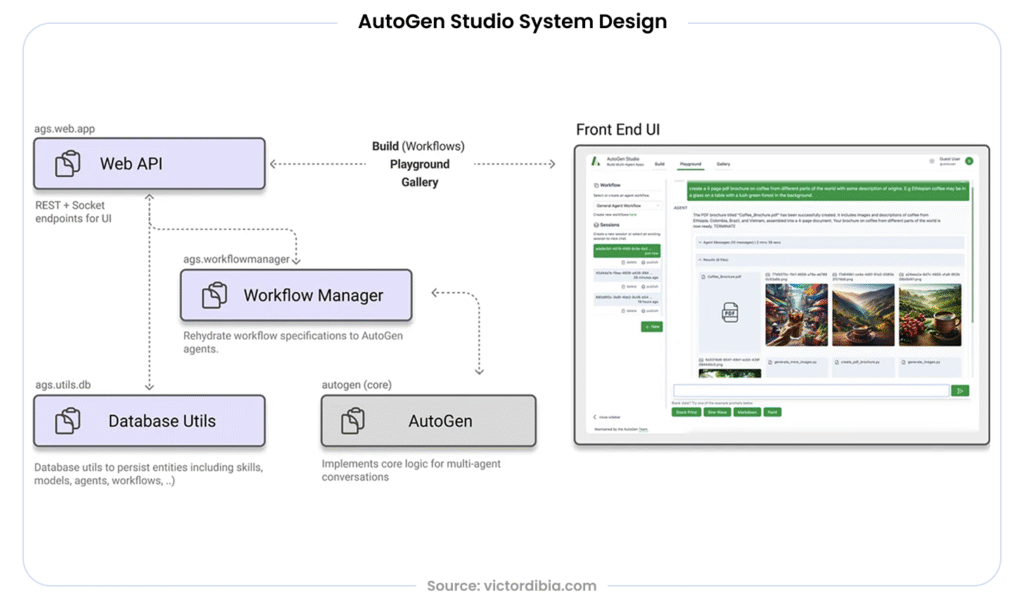
- Sequential and autonomous chat workflow options
- Pre-built agent templates and component library
- Support for multiple deployment options, horizontally-scaling servers, task queues, and built-in persistence
- Community-driven development with active GitHub ecosystem
Version & Status: As of January 2025, AutoGen Studio has been rewritten on the new v0.4 API, built on the high-level AutoGen AgentChat API.
Pricing Model: AutoGen is an open-source AI development framework that starts from free (open source). Costs depend on your chosen LLM provider (e.g., OpenAI API costs).
Key Feature Comparison Table 1: Architecture & Flexibility
| Feature | OpenAI Agent Builder | LangGraph | AutoGen Studio |
| Architecture Type | Visual canvas-based | Graph-based (directed acyclic) | Low-code GUI on framework |
| Workflow Types | Linear, conditional, tool-based | Linear, parallel, hierarchical, looped | Sequential, autonomous chat |
| Code Required | Minimal (visual design) | Advanced (Python-based) | Minimal to none |
| Customization Level | High (within OpenAI ecosystem) | Very high (full control) | Medium (template-based) |
| State Management | Version control, snapshots | Persistent checkpointing with time-travel | Session-based memory |
| Multi-Agent Support | Yes (via orchestration) | Native and advanced | Yes (team-based) |
| Language Support | API-based (language agnostic) | Python, JavaScript | Python, .NET |
| Production Readiness | Enterprise-grade (beta) | Production-ready | Research/prototype phase |
Key Feature Comparison Table 2: Observability, Pricing & Integration
| Feature | OpenAI Agent Builder | LangGraph | AutoGen Studio |
| Observability Tools | Built-in tracing, evals | LangSmith integration, Studio debugger | Basic UI-based debugging |
| Human-in-Loop | Guardrails, confirmations | Native interrupts, checkpoints | Limited support |
| Free Tier | Design free, execution pay-per-use | Open-source free | Open-source free |
| Paid Plans | Usage-based (models + tools) | LangSmith Plus: $39/month | Hosting costs only |
| Tool Integration | Connector Registry (API management) | LangChain ecosystem, vector DBs | Built-in tools, extensions |
| Deployment Options | OpenAI cloud, ChatKit embed | Self-hosted or LangSmith platform | Local or self-hosted |
| Enterprise Features | SSO, RBAC, audit logs | Multi-vendor support, fine-grained control | Limited |
| Learning Curve | Moderate (visual interface) | Steep (graph theory required) | Low to moderate |
Technical Architecture Deep Dive
OpenAI Agent Builder: Reinforcement Fine-Tuning & Rapid Iteration
OpenAI’s approach prioritizes developer speed and ease of use. The platform implements reinforcement fine-tuning (RFT) to optimize agent behavior based on user feedback and performance metrics. File Search costs $0.10 per gigabyte of storage per day, while Code Interpreter costs $0.03 per session.
The architecture emphasizes integration with OpenAI’s model suite, enabling teams to leverage GPT-5 and benefit from continuous model improvements without code changes.
LangGraph: Directed Graphs & Distributed Orchestration
LangGraph models workflows as mathematical graphs, where each node is responsible for a specific task. These tasks can range from calling a language model, interacting with external tools, or executing custom business logic. LangGraph’s standout feature is its ability to maintain shared, persistent states across workflows, allowing dynamic adjustments based on runtime conditions.
This architecture supports advanced patterns, including:
- Scatter-Gather: Distributing tasks to multiple agents and consolidating results
- Pipeline Parallelism: Concurrent processing of sequential stages
- Subgraph Composition: Modular, reusable agent clusters
AutoGen: Event-Driven Message Passing
AutoGen provides multi-agent conversation framework as a high-level abstraction. With this framework, one can conveniently build LLM workflows. AutoGen offers a collection of working systems spanning a wide range of applications from various domains and complexities.
The framework emphasizes conversation-centric orchestration, where agents communicate through natural language, enabling human-like collaboration patterns.
Real-World Case Studies: AI Agents Delivering Impact
Case Study 1: Klarna’s Customer Service Revolution
Klarna, the AI powered global payments network and shopping assistant, deployed an AI assistant that had 2.3 million conversations, two-thirds of Klarna’s customer service chats.
It is doing the equivalent work of 700 full-time agents, on par with human agents in regard to customer satisfaction score, more accurate in errand resolution, leading to a 25% drop in repeat inquiries, and customers now resolve their errands in less than 2 mins compared to 11 mins previously.
It’s available in 23 markets, 24/7 and communicates in more than 35 languages. It’s estimated to drive a $40 million USD in profit improvement to Klarna in 2024.
Case Study 2: Ramp’s Intelligent Expense Management
Ramp, a financial technology company, developed an AI-powered expense categorization solution rooted in machine learning algorithms to address manual expense management challenges. The system could quickly identify patterns and map expenses to the appropriate budget categories by analyzing historical spending data. The deployment of Ramp’s automated categorization system resulted in decreased manual corrections, freeing up valuable time and resources for higher-level functions.
Case Study 3: Enterprise Research: LangGraph at Qualtrics
For companies like Qualtrics, centralizing agent management with LangGraph Platform has been critical to driving efficiency: “The future of agentic AI is multi-vendor and AI agents must be built in an ecosystem. By using LangGraph Platform to build and manage our AI agents – Experience Agents – Qualtrics is able to design, deploy, and manage complex generative AI agent workflows with efficiency, speed, and scale”.

Use Cases & Suitability: Making Your Choice
When to Choose OpenAI Agent Builder
Best For: Enterprise applications needing production-grade solutions, fast iteration cycles, and deep integration with OpenAI models.
Ideal Scenarios:
- Organizations standardized on OpenAI infrastructure
- Teams prioritizing speed-to-market over customization depth
- Customer-facing agent applications with embeddable chat interfaces
- Companies valuing built-in evaluations and observability
When to Choose LangGraph
Best For: Complex, highly customizable multi-agent architectures requiring detailed control and extensive human oversight.
Ideal Scenarios:
- Research organizations building novel agent coordination patterns
- Enterprises with complex data pipelines and state management needs
- Teams requiring time-travel debugging and detailed performance analysis
- Applications demanding real-time human intervention capabilities
When to Choose AutoGen Studio
Best For: Rapid prototyping, research, multi-agent experimentation, and educational applications.
Ideal Scenarios:
- Academic researchers exploring multi-agent AI concepts
- Startups validating agent-based product ideas
- Teams building proof-of-concepts before enterprise deployment
- Organizations seeking low-code rapid prototyping tools
Pros and Cons Summary
OpenAI Agent Builder
Pros
✓ Exceptional speed to production (2 hours to live agents at Ramp)
✓ Built-in evaluation and optimization tools
✓ Excellent for teams prioritizing OpenAI ecosystems
✓ Visual interface accessible to non-technical stakeholders
Cons
✗ Still in beta (October 2025)
✗ Limited to OpenAI model ecosystem
✗ Less flexible for novel multi-agent patterns
✗ Usage-based pricing can become expensive at scale
LangGraph
Pros
✓ Unmatched flexibility for complex workflows
✓ True open-source (MIT license)
✓ Exceptional debugging tools (time-travel capability)
✓ Proven enterprise adoption at scale
Cons
✗ Steep learning curve (requires graph theory understanding)
✗ Requires Python coding expertise
✗ Infrastructure complexity for production deployment
✗ Debugging complex workflows can be challenging
AutoGen Studio
Pros
✓ Lowest barrier to entry (no-code interface)
✓ Excellent for rapid prototyping
✓ Active community with rich ecosystem
✓ Free and open-source
Cons
✗ Not production-ready (research prototype phase)
✗ Limited enterprise features
✗ Restricted multi-agent patterns
✗ Scaling challenges for complex workflows
How to Choose Based on Your Needs
Decision Matrix: Technical Readiness
Your Team’s Expertise Level:
- Non-technical/Business: AutoGen Studio → OpenAI Agent Builder
- Python Developers: OpenAI Agent Builder → LangGraph
- Advanced Engineers: LangGraph (full capabilities)
Decision Matrix: Project Requirements
Scale & Complexity:
- POC/Prototype: AutoGen Studio
- Production, Single Region: OpenAI Agent Builder
- Enterprise, Multi-Region: LangGraph
Customization Needs:
- Standard Workflows: OpenAI Agent Builder
- Unique Patterns: LangGraph
- Learning/Research: AutoGen Studio
Budget Constraints:
- Minimal: AutoGen Studio (free + LLM costs)
- Moderate: OpenAI Agent Builder (pay-per-use)
- Enterprise: LangGraph + LangSmith Platform

Source: Team TechAhead AI Team
Future Outlook: The Agentic AI Landscape in 2025-2026
The agentic AI space is evolving rapidly. Azure AI Foundry Agent Service is now Generally Available, bringing Semantic Kernel and AutoGen into a single, developer-focused SDK with Agent-to-Agent (A2A) and Model Context Protocol (MCP) support for enterprise-focused multi-agent orchestration.
Expect these trends to accelerate:
- Standardization: Model Context Protocol (MCP) and A2A standards becoming industry norms
- Multi-Vendor Orchestration: Agents seamlessly coordinating across multiple LLM providers
- Enhanced Safety: Stronger guardrails, prompt injection mitigations, and human-in-loop defaults
- Cost Optimization: Improved tooling for cost-per-task metrics and intelligent routing to cheaper models
- Developer Experience: Better debugging, testing frameworks, and agent benchmarking tools
Conclusion: Your Path Forward
The choice between OpenAI Agent Builder, LangGraph, and AutoGen Studio isn’t about picking the “best” tool—it’s about selecting the right tool for your specific context.
Choose OpenAI Agent Builder if you prioritize speed, deep integration with OpenAI models, and need something production-ready quickly.
Choose LangGraph if you’re building complex, customizable multi-agent systems and value flexibility, open-source standards, and advanced debugging capabilities.
Choose AutoGen Studio if you’re in the research or rapid prototyping phase and want the lowest barrier to entry for exploring multi-agent AI concepts.
The winning organizations of the next decade will be those that successfully harness agentic AI to automate complex workflows, reduce costs, and enable their teams to focus on strategic work. The tools exist today. The question is: will you act?
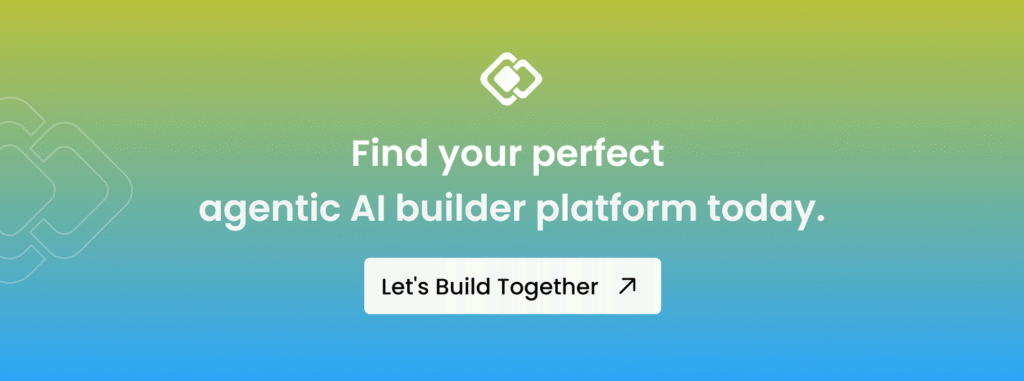
AI agents reason through problems autonomously, execute multi-step workflows, use tools independently, and handle complex scenarios without constant user guidance. Chatbots typically follow scripted paths and respond to user queries reactively.
Partially. LangGraph offers the most portability since it’s open-source and framework-agnostic. OpenAI Agent Builder can export to SDK. AutoGen Studio is designed for prototyping before migration. Plan for some migration effort.
AutoGen Studio has lowest software costs (free) but requires infrastructure management. OpenAI Agent Builder has predictable usage costs. LangGraph has predictable infrastructure costs through LangSmith. Evaluate your specific utilization patterns.
Yes, but to different degrees. LangGraph has the most sophisticated human-in-loop capabilities. OpenAI Agent Builder has guardrails and confirmation prompts. AutoGen Studio has basic support requiring custom implementation.
OpenAI Agent Builder and LangGraph can with proper infrastructure. AutoGen Studio’s latency depends on deployment configuration. For sub-100ms requirements, careful architectural planning is essential regardless of platform choice.
AutoGen Studio: 1-2 weeks for basics. OpenAI Agent Builder: 2-3 weeks due to visual interface learning. LangGraph: 4-8 weeks due to graph-based abstraction complexity and Python requirement.




